I'm able to run a t-test or a Wilcoxon test on the data with no warnings, but I get an error when I try to plot in with ggpubr 's function stat_pvalue_manual() in ggplot2
- The t-test works fine:
### running a t-test (no problem):
t.test(SUJ_PRE ~ AMOSTRA, data = data, exact = F)
- But I get the error in
stat_pvalue_manual:
### trying to plot it:
data %>%
ggplot(., aes(x = AMOSTRA, y = SUJ_PRE)) +
stat_boxplot(geom = "errorbar",
width = 0.15) +
geom_boxplot(aes(fill = AMOSTRA), outlier.colour = "#9370DB", outlier.shape = 19,
outlier.size= 2, notch = T) +
scale_fill_manual(values = c("PB" = "#E6E6FA", "PE" = "#CCCCFF"),
label = c("PB" = "PB", "PE" = "PE"),
name = "Amostra:") +
stat_summary(fun = mean, geom = "point", shape = 20, size= 5, color= "#9370DB") +
stat_pvalue_manual(data %>%
t_test(SUJ_PRE ~ AMOSTRA) %>%
add_xy_position(),
label = "t = {round(statistic, 2)}, p = {p}")
Error in `mutate()`:
! Problem while computing `data = map(.data$data, .f, ...)`.
Caused by error in `t.test.default()`:
! not enough 'x' observations
With
SUJ_PREI'm getting the error with 'x' , but I've also got the 'y' message with another variable too. Any thoughts on that? I've seem some similar questions, but I couldn't solve my problem. Thanks in advance.data:
> dput(data)
structure(list(ID = c("COPA_M1B", "COPA_M1C", "COPA_M2B", "COPA_M2C",
"COPA_M3C", "COPA_M3A", "COPA_M3B", "COPA_H1A", "COPA_H1B", "COPA_H2A",
"COPA_H2B", "COPA_H2C", "COPA_H3A", "COPA_H3B", "NI_M1B", "NI_M1C",
"NI_M2A", "NI_M2B", "NI_M3C", "NI_M3A", "NI_M3B", "NI_H1A", "NI_H1B",
"NI_H1C", "NI_H2B", "NI_H2C", "NI_H3A", "NI_H3C", "CACEM_M1A",
"CACEM_M1B", "CACEM_M1C", "CACEM_M2B", "CACEM_M3B", "CACEM_H1B",
"CACEM_H1C", "CACEM_H2A", "CACEM_H2C", "OEIRAS_M1B", "OEIRAS_M1C",
"OEIRAS_M2B", "OEIRAS_M3B", "OEIRAS_M3C", "OEIRAS_H1B"), SUJ_PRE = c(25,
40, 56, 49, 47, 38, 58, 38, 42, 71, 43, 46, 74, 43, 45, 35, 70,
33, 45, 53, 50, 59, 62, 41, 35, 43, 40, 21, 23, 33, 35, 21, 36,
15, 31, 19, 31, 20, 22, 20, 19, 21, 25), AMOSTRA = structure(c(1L,
1L, 1L, 1L, 1L, 1L, 1L, 1L, 1L, 1L, 1L, 1L, 1L, 1L, 1L, 1L, 1L,
1L, 1L, 1L, 1L, 1L, 1L, 1L, 1L, 1L, 1L, 1L, 2L, 2L, 2L, 2L, 2L,
2L, 2L, 2L, 2L, 2L, 2L, 2L, 2L, 2L, 2L), .Label = c("PB", "PE"
), class = "factor")), class = c("grouped_df", "tbl_df", "tbl",
"data.frame"), row.names = c(NA, -43L), groups = structure(list(
ID = c("CACEM_H1B", "CACEM_H1C", "CACEM_H2A", "CACEM_H2C",
"CACEM_M1A", "CACEM_M1B", "CACEM_M1C", "CACEM_M2B", "CACEM_M3B",
"COPA_H1A", "COPA_H1B", "COPA_H2A", "COPA_H2B", "COPA_H2C",
"COPA_H3A", "COPA_H3B", "COPA_M1B", "COPA_M1C", "COPA_M2B",
"COPA_M2C", "COPA_M3A", "COPA_M3B", "COPA_M3C", "NI_H1A",
"NI_H1B", "NI_H1C", "NI_H2B", "NI_H2C", "NI_H3A", "NI_H3C",
"NI_M1B", "NI_M1C", "NI_M2A", "NI_M2B", "NI_M3A", "NI_M3B",
"NI_M3C", "OEIRAS_H1B", "OEIRAS_M1B", "OEIRAS_M1C", "OEIRAS_M2B",
"OEIRAS_M3B", "OEIRAS_M3C"), .rows = structure(list(34L,
35L, 36L, 37L, 29L, 30L, 31L, 32L, 33L, 8L, 9L, 10L,
11L, 12L, 13L, 14L, 1L, 2L, 3L, 4L, 6L, 7L, 5L, 22L,
23L, 24L, 25L, 26L, 27L, 28L, 15L, 16L, 17L, 18L, 20L,
21L, 19L, 43L, 38L, 39L, 40L, 41L, 42L), ptype = integer(0), class = c("vctrs_list_of",
"vctrs_vctr", "list"))), row.names = c(NA, -43L), class = c("tbl_df",
"tbl", "data.frame"), .drop = TRUE))
